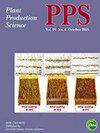Effect of leaf thinning on shoot growth and tuber yield of white Guinea yam
IF 1.3
3区 农林科学
Q2 AGRONOMY
引用次数: 4
Abstract
ABSTRACT Mutual leaf shading can inhibit the growth of yam, reducing tuber yield. To improve light utilization, approximately 25% of leaves in a plant were thinned during the period of maximum shoot growth. Shoot dry weight was estimated every two weeks using a non-destructive method. Leaf thinning caused higher shoot growth rates (SGRs) after thinning, while control plants had SGRs close to zero. The higher SGRs in the thinned plants was attributed to an increase in new leaf development. This indicates that the plateau in shoot growth commonly observed during the late growth period is reversible and could be improved artificially. In thinned plants, there was a positive relationship between shoot dry weight and SGR, although no such relationship was observed in control plants after the middle growth period. This positive correlation indicates a higher shoot growth per unit leaf area in the thinned plants than in the control plants, presumably due to improved light utilization and a higher photosynthetic rate of new leaves. However, leaf thinning reduced tuber yields, presumably because of a lower total carbon assimilation per plant and greater growth competition between shoots and tubers. High correlations between shoot dry weight and tuber yield indicated that a high shoot biomass is more important than improving light utilization for increased tuber yields. Graphical abstract间伐对白几内亚山药茎部生长和块茎产量的影响
相互遮荫可以抑制甘薯的生长,降低块茎产量。为了提高光照利用率,在枝条生长最旺盛的时期,植物中大约25%的叶片被稀疏。用非破坏性方法每两周估计一次芽干重。叶片稀疏导致稀疏后的芽生长率(SGR)更高,而对照植物的SGR接近于零。间伐植物中较高的SGR归因于新叶发育的增加。这表明,在生长后期通常观察到的地上部生长平台是可逆的,可以人工改善。在间伐植物中,茎干重与SGR之间存在正相关关系,尽管在生长中期后的对照植物中没有观察到这种关系。这种正相关关系表明,与对照植物相比,稀疏植物的单位叶面积芽生长更高,这可能是由于光利用率的提高和新叶的光合速率的提高。然而,叶片变薄降低了块茎产量,可能是因为单株总碳同化率较低,枝条和块茎之间的生长竞争更大。茎干重与块茎产量之间的高度相关性表明,对于提高块茎产量,高茎生物量比提高光照利用率更重要。图形摘要
本文章由计算机程序翻译,如有差异,请以英文原文为准。
求助全文
约1分钟内获得全文
求助全文
来源期刊

Plant Production Science
农林科学-农艺学
CiteScore
5.10
自引率
4.00%
发文量
27
审稿时长
>36 weeks
期刊介绍:
Plant Production Science publishes original research reports on field crops and resource plants, their production and related subjects, covering a wide range of sciences; physiology, biotechnology, morphology, ecology, cropping system, production technology and post harvest management. Studies on plant production with special attention to resource management and the environment are also welcome. Field surveys on cropping or farming system are also accepted. Articles with a background in other research areas such as soil science, meteorology, biometry, product process and plant protection will be accepted as long as they are significantly related to plant production.
 求助内容:
求助内容: 应助结果提醒方式:
应助结果提醒方式:


